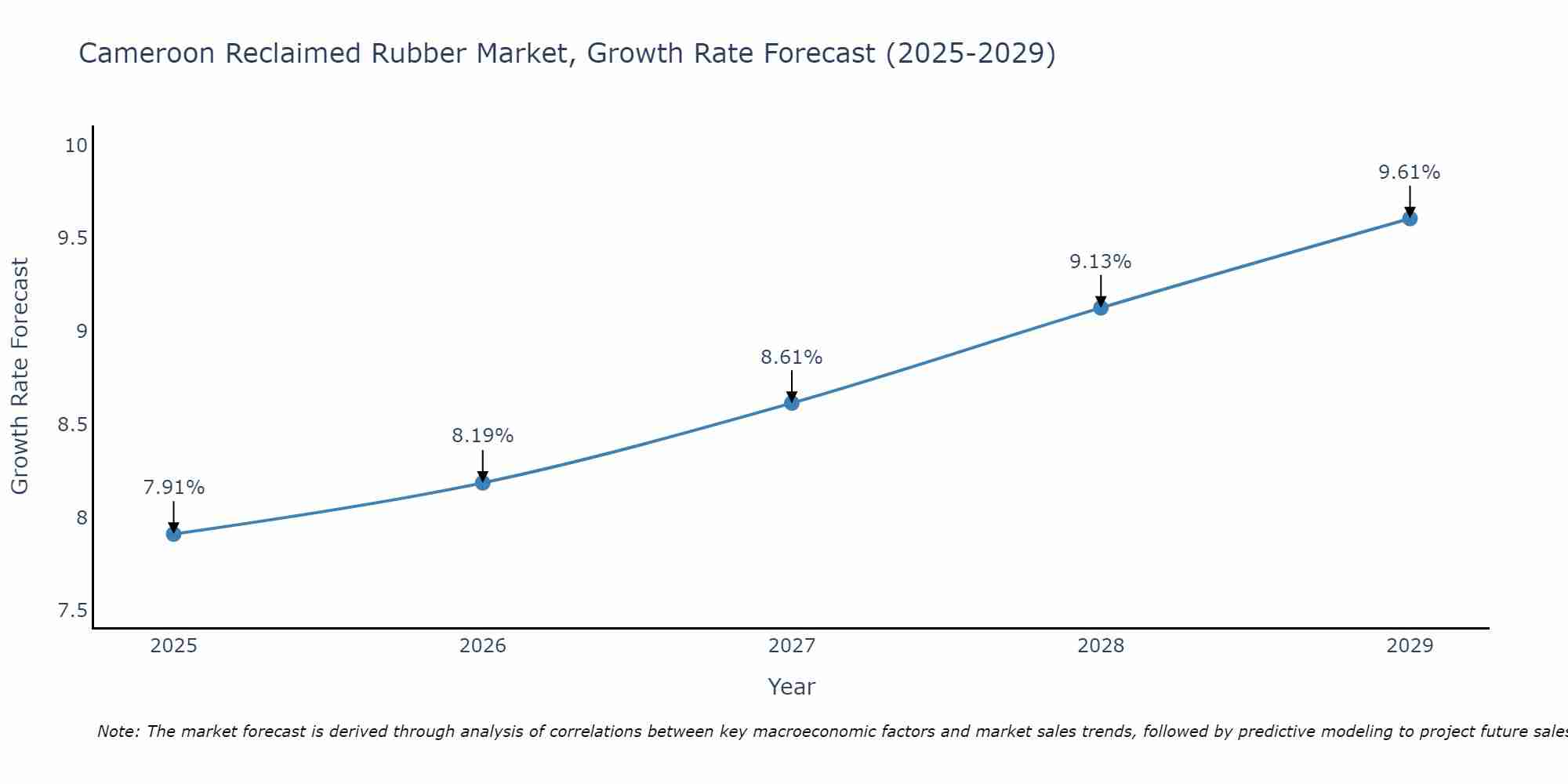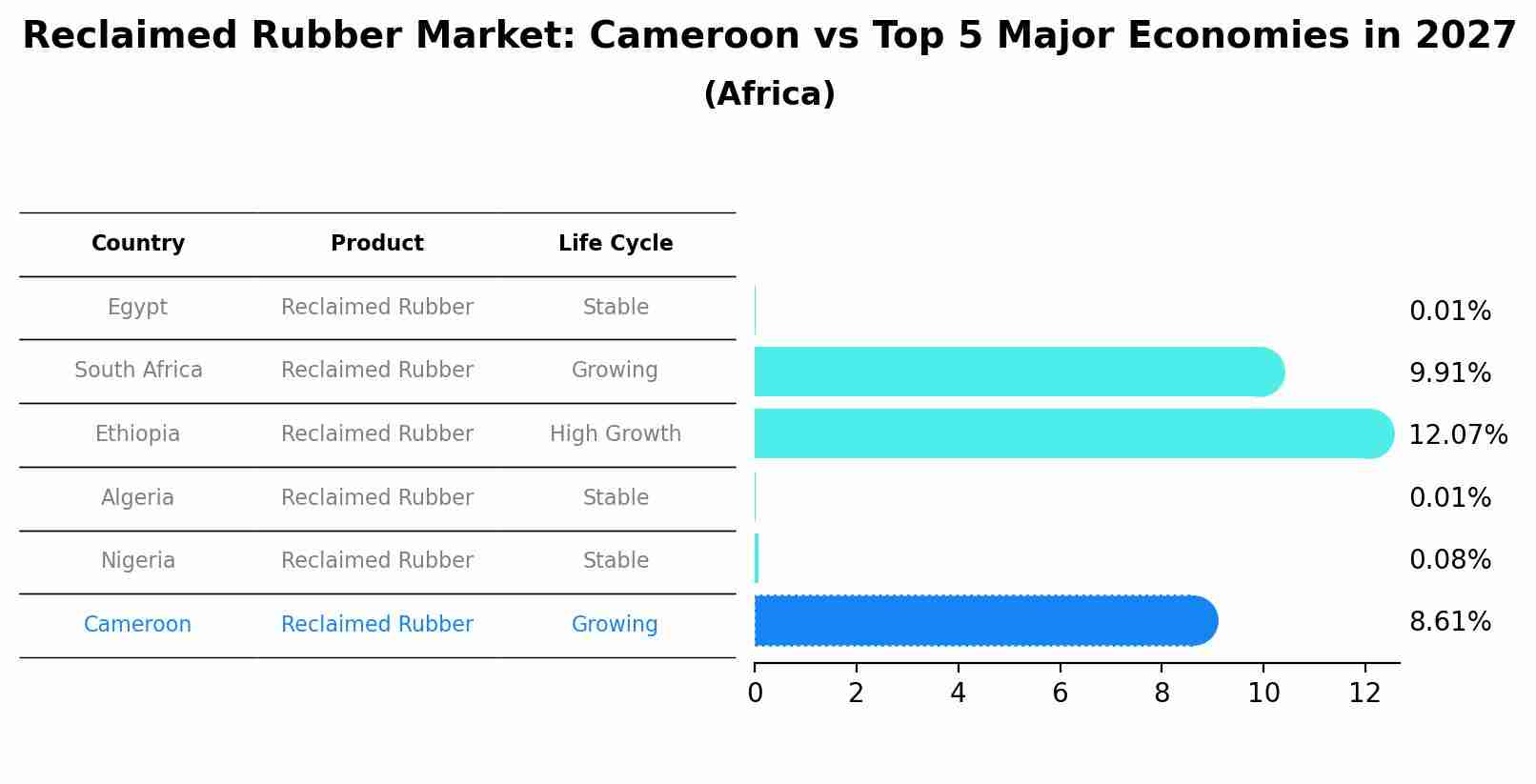Cameroon Reclaimed Rubber Market (2025-2031) | Companies, Analysis, Share, Value, Size, Industry, Revenue, Growth, Segmentation, Outlook, Trends & Forecast
| Product Code: ETC4711273 | Publication Date: Nov 2023 | Updated Date: Apr 2025 | Product Type: Market Research Report | |
| Publisher: 6Wresearch | Author: Shubham Deep | No. of Pages: 60 | No. of Figures: 30 | No. of Tables: 5 |
Cameroon Reclaimed Rubber Market Size Growth Rate
The Cameroon Reclaimed Rubber Market is likely to experience consistent growth rate gains over the period 2025 to 2029. Commencing at 7.91% in 2025, growth builds up to 9.61% by 2029.

Reclaimed Rubber Market: Cameroon vs Top 5 Major Economies in 2027 (Africa)
Cameroon's Reclaimed Rubber market is anticipated to experience a growing growth rate of 8.61% by 2027, reflecting trends observed in the largest economy Egypt, followed by South Africa, Ethiopia, Algeria and Nigeria.

Cameroon Reclaimed Rubber Market Overview
The reclaimed rubber market in Cameroon is growing due to the increasing use of reclaimed rubber in various applications, including tires and industrial products. Reclaimed rubber offers cost benefits and environmental advantages by recycling used rubber. The market growth is supported by sustainability initiatives and rising demand for eco-friendly materials. Challenges include the quality and consistency of reclaimed rubber and competition from alternative materials.
Drivers of the market
The reclaimed rubber market in Cameroon is driven by the increasing focus on sustainability and recycling in the rubber industry. Reclaimed rubber, produced from recycled rubber products, offers a cost-effective and environmentally friendly alternative to virgin rubber. The growth of the automotive and industrial sectors, along with rising awareness of waste management and circular economy practices, fuels the demand for reclaimed rubber. Additionally, advancements in recycling technologies and the expansion of rubber recycling infrastructure contribute to market growth.
Challenges of the market
The reclaimed rubber market in Cameroon encounters challenges related to the high cost of rubber recycling technologies and the lack of local processing facilities. The market is also affected by limited awareness and understanding of the benefits and applications of reclaimed rubber in industries such as automotive, construction, and manufacturing. Additionally, the market faces competition from virgin rubber and synthetic alternatives, which are often preferred due to their consistent quality and availability. Economic constraints and the lack of investment in recycling infrastructure further challenge market growth.
Government Policy of the market
The government promotes the reclaimed rubber market by supporting recycling and sustainability initiatives. Policies include regulations for the processing and use of reclaimed rubber, providing incentives for companies involved in recycling, and supporting research into advanced rubber technologies. The government aims to reduce waste and promote the use of reclaimed materials in various applications.
Key Highlights of the Report:
- Cameroon Reclaimed Rubber Market Outlook
- Market Size of Cameroon Reclaimed Rubber Market, 2024
- Forecast of Cameroon Reclaimed Rubber Market, 2031
- Historical Data and Forecast of Cameroon Reclaimed Rubber Revenues & Volume for the Period 2021-2031
- Cameroon Reclaimed Rubber Market Trend Evolution
- Cameroon Reclaimed Rubber Market Drivers and Challenges
- Cameroon Reclaimed Rubber Price Trends
- Cameroon Reclaimed Rubber Porter`s Five Forces
- Cameroon Reclaimed Rubber Industry Life Cycle
- Historical Data and Forecast of Cameroon Reclaimed Rubber Market Revenues & Volume By Product for the Period 2021-2031
- Historical Data and Forecast of Cameroon Reclaimed Rubber Market Revenues & Volume By Whole Tire Reclaim (WTR) for the Period 2021-2031
- Historical Data and Forecast of Cameroon Reclaimed Rubber Market Revenues & Volume By Butyl Reclaim for the Period 2021-2031
- Historical Data and Forecast of Cameroon Reclaimed Rubber Market Revenues & Volume By EPDM for the Period 2021-2031
- Historical Data and Forecast of Cameroon Reclaimed Rubber Market Revenues & Volume By Drab & Colored for the Period 2021-2031
- Historical Data and Forecast of Cameroon Reclaimed Rubber Market Revenues & Volume By Others for the Period 2021-2031
- Historical Data and Forecast of Cameroon Reclaimed Rubber Market Revenues & Volume By Application for the Period 2021-2031
- Historical Data and Forecast of Cameroon Reclaimed Rubber Market Revenues & Volume By Automotive & Aircraft Tires for the Period 2021-2031
- Historical Data and Forecast of Cameroon Reclaimed Rubber Market Revenues & Volume By Cycle Tires for the Period 2021-2031
- Historical Data and Forecast of Cameroon Reclaimed Rubber Market Revenues & Volume By Retreading for the Period 2021-2031
- Historical Data and Forecast of Cameroon Reclaimed Rubber Market Revenues & Volume By Belts & Hoses for the Period 2021-2031
- Historical Data and Forecast of Cameroon Reclaimed Rubber Market Revenues & Volume By Footwear for the Period 2021-2031
- Historical Data and Forecast of Cameroon Reclaimed Rubber Market Revenues & Volume By Molded Goods for the Period 2021-2031
- Historical Data and Forecast of Cameroon Reclaimed Rubber Market Revenues & Volume By Others for the Period 2021-2031
- Cameroon Reclaimed Rubber Import Export Trade Statistics
- Market Opportunity Assessment By Product
- Market Opportunity Assessment By Application
- Cameroon Reclaimed Rubber Top Companies Market Share
- Cameroon Reclaimed Rubber Competitive Benchmarking By Technical and Operational Parameters
- Cameroon Reclaimed Rubber Company Profiles
- Cameroon Reclaimed Rubber Key Strategic Recommendations
Frequently Asked Questions About the Market Study (FAQs):
1 Executive Summary |
2 Introduction |
2.1 Key Highlights of the Report |
2.2 Report Description |
2.3 Market Scope & Segmentation |
2.4 Research Methodology |
2.5 Assumptions |
3 Cameroon Reclaimed Rubber Market Overview |
3.1 Cameroon Country Macro Economic Indicators |
3.2 Cameroon Reclaimed Rubber Market Revenues & Volume, 2021 & 2031F |
3.3 Cameroon Reclaimed Rubber Market - Industry Life Cycle |
3.4 Cameroon Reclaimed Rubber Market - Porter's Five Forces |
3.5 Cameroon Reclaimed Rubber Market Revenues & Volume Share, By Product, 2021 & 2031F |
3.6 Cameroon Reclaimed Rubber Market Revenues & Volume Share, By Application, 2021 & 2031F |
4 Cameroon Reclaimed Rubber Market Dynamics |
4.1 Impact Analysis |
4.2 Market Drivers |
4.3 Market Restraints |
5 Cameroon Reclaimed Rubber Market Trends |
6 Cameroon Reclaimed Rubber Market Segmentations |
6.1 Cameroon Reclaimed Rubber Market, By Product |
6.1.1 Overview and Analysis |
6.1.2 Cameroon Reclaimed Rubber Market Revenues & Volume, By Whole Tire Reclaim (WTR), 2021-2031F |
6.1.3 Cameroon Reclaimed Rubber Market Revenues & Volume, By Butyl Reclaim, 2021-2031F |
6.1.4 Cameroon Reclaimed Rubber Market Revenues & Volume, By EPDM, 2021-2031F |
6.1.5 Cameroon Reclaimed Rubber Market Revenues & Volume, By Drab & Colored, 2021-2031F |
6.1.6 Cameroon Reclaimed Rubber Market Revenues & Volume, By Others, 2021-2031F |
6.2 Cameroon Reclaimed Rubber Market, By Application |
6.2.1 Overview and Analysis |
6.2.2 Cameroon Reclaimed Rubber Market Revenues & Volume, By Automotive & Aircraft Tires, 2021-2031F |
6.2.3 Cameroon Reclaimed Rubber Market Revenues & Volume, By Cycle Tires, 2021-2031F |
6.2.4 Cameroon Reclaimed Rubber Market Revenues & Volume, By Retreading, 2021-2031F |
6.2.5 Cameroon Reclaimed Rubber Market Revenues & Volume, By Belts & Hoses, 2021-2031F |
6.2.6 Cameroon Reclaimed Rubber Market Revenues & Volume, By Footwear, 2021-2031F |
6.2.7 Cameroon Reclaimed Rubber Market Revenues & Volume, By Molded Goods, 2021-2031F |
7 Cameroon Reclaimed Rubber Market Import-Export Trade Statistics |
7.1 Cameroon Reclaimed Rubber Market Export to Major Countries |
7.2 Cameroon Reclaimed Rubber Market Imports from Major Countries |
8 Cameroon Reclaimed Rubber Market Key Performance Indicators |
9 Cameroon Reclaimed Rubber Market - Opportunity Assessment |
9.1 Cameroon Reclaimed Rubber Market Opportunity Assessment, By Product, 2021 & 2031F |
9.2 Cameroon Reclaimed Rubber Market Opportunity Assessment, By Application, 2021 & 2031F |
10 Cameroon Reclaimed Rubber Market - Competitive Landscape |
10.1 Cameroon Reclaimed Rubber Market Revenue Share, By Companies, 2024 |
10.2 Cameroon Reclaimed Rubber Market Competitive Benchmarking, By Operating and Technical Parameters |
11 Company Profiles |
12 Recommendations | 13 Disclaimer |
- Single User License$ 1,995
- Department License$ 2,400
- Site License$ 3,120
- Global License$ 3,795
Search
Related Reports
- Australia IT Asset Disposal Market (2025-2031) | Strategy, Consumer Insights, Analysis, Investment Trends, Opportunities, Growth, Size, Share, Industry, Revenue, Segments, Value, Segmentation, Supply, Forecast, Restraints, Outlook, Competition, Drivers, Trends, Demand, Pricing Analysis, Competitive, Strategic Insights, Companies, Challenges
- UAE Building Thermal Insulation Market Outlook (2025-2031) | Revenue, Companies, Share, Trends, Growth, Size, Forecast, Industry, Analysis & Value
- Portugal Electronic Document Management Market (2025-2031) | Strategy, Consumer Insights, Analysis, Investment Trends, Opportunities, Growth, Size, Share, Industry, Revenue, Segments, Value, Segmentation, Supply, Forecast, Restraints, Outlook, Competition, Drivers, Trends, Demand, Pricing Analysis, Competitive, Strategic Insights, Companies, Challenges
- France Electronic Document Management Market (2025-2031) | Strategy, Consumer Insights, Analysis, Investment Trends, Opportunities, Growth, Size, Share, Industry, Revenue, Segments, Value, Segmentation, Supply, Forecast, Restraints, Outlook, Competition, Drivers, Trends, Demand, Pricing Analysis, Competitive, Strategic Insights, Companies, Challenges
- Portugal Occupational Health & Safety Services Market (2025-2031) | Strategy, Consumer Insights, Analysis, Investment Trends, Opportunities, Growth, Size, Share, Industry, Revenue, Segments, Value, Segmentation, Supply, Forecast, Restraints, Outlook, Competition, Drivers, Trends, Demand, Pricing Analysis, Competitive, Strategic Insights, Companies, Challenges
- Netherlands Occupational Health and Safety Services Market (2025-2031) | Strategy, Consumer Insights, Analysis, Investment Trends, Opportunities, Growth, Size, Share, Industry, Revenue, Segments, Value, Segmentation, Supply, Forecast, Restraints, Outlook, Competition, Drivers, Trends, Demand, Pricing Analysis, Competitive, Strategic Insights, Companies, Challenges
- Belgium and Luxembourg Facility Management Market (2025-2031) | Strategy, Consumer Insights, Analysis, Investment Trends, Opportunities, Growth, Size, Share, Industry, Revenue, Segments, Value, Segmentation, Supply, Forecast, Restraints, Outlook, Competition, Drivers, Trends, Demand, Pricing Analysis, Competitive, Strategic Insights, Companies, Challenges
- Russia Women Intimate Apparel Market (2025-2031) | Strategy, Consumer Insights, Analysis, Investment Trends, Opportunities, Growth, Size, Share, Industry, Revenue, Segments, Value, Segmentation, Supply, Forecast, Restraints, Outlook, Competition, Drivers, Trends, Demand, Pricing Analysis, Competitive, Strategic Insights, Companies, Challenges
- Africa Chocolate Market (2025-2031) | Size, Share, Trends, Growth, Revenue, Analysis, Forecast, industry & Outlook
- Global Hydroxychloroquine And Chloroquine Market (2025-2031) | Industry, Trends, Size, Outlook, Growth, Value, Companies, Revenue, Analysis, Share, Forecast
Industry Events and Analyst Meet
Our Clients
Whitepaper
- Middle East & Africa Commercial Security Market Click here to view more.
- Middle East & Africa Fire Safety Systems & Equipment Market Click here to view more.
- GCC Drone Market Click here to view more.
- Middle East Lighting Fixture Market Click here to view more.
- GCC Physical & Perimeter Security Market Click here to view more.
6WResearch In News
- Doha a strategic location for EV manufacturing hub: IPA Qatar
- Demand for luxury TVs surging in the GCC, says Samsung
- Empowering Growth: The Thriving Journey of Bangladesh’s Cable Industry
- Demand for luxury TVs surging in the GCC, says Samsung
- Video call with a traditional healer? Once unthinkable, it’s now common in South Africa
- Intelligent Buildings To Smooth GCC’s Path To Net Zero













